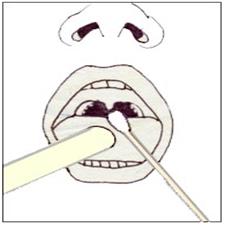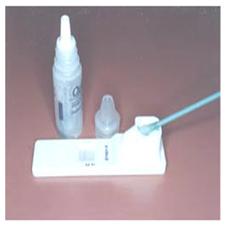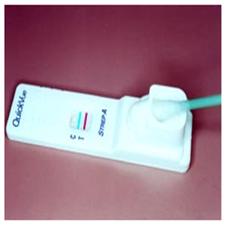현미경 세균 검사(현미경 박테리아 검사), 세균배양 검사와 항생제 감수성 검사, Microscopic bacterial examination, Bacterial culture, Antimicrobial susceptibility test(Antimicrobial sensitivity test)
-
박테리아(세균)가 인체에 감염되면 신체의 여러 계통 중 어느 한 계통의 한기관이나 조직, 또는 한 국소에 제한되어 거기에 감염병을 일으킬 수 있고, 그 박테리아가 짧은 시간 내 전신으로 퍼져 신체의 여러 계통의 여러 기관, 여러 부위, 조직에 감염병을 동시 일으킬 수 있다.
-
박테리아 감염병이 있거나 또는 있다고 의심되는 감염병의 병소에서 점액, 피, 고름, 분비물, 또는 생체 조직의 일부를 채취한 피검 물로 그람 염색을 하고 현미경 세균 검사, 세균 배양검사, 항생제 세균 감수성 검사(항생제 감수성 검사) 등 여러 가지 세균검사를 할 수 있다.
-
피검 물로 그람 염색 검사도 하고 세균 현미경 검사도 하고, 세균 배양 검사를 하고 필요에 따라 세균 항생제 감수성 검사(세균 항생제 감수성 시험) 등을 한다.
-
그 검사에서 찾아낸 세균을 죽이는데 가장 치료 효력이 있는 항생제로 그 박테리아 감염병을 치료하는 것이 가장 이상적인 세균 감염병 치료방법이다.
-
이런 검사들을 통틀어 세균 검사라고 할 수 있다.
-
예를 들면, 박테리아 관절염이 무릎관절에 생겼다고 가정하자.
-
그 관절 속에 든 고름을 주사 바늘로 뺀 다음 그 뺀 고름으로 세균 검사를 할 수 있다. 이 때 그 고름을 피검 물이라 한다.
-
피검 물을 우선 육안으로 조심히 관찰한다. 피만 있는지 고름만 있는지 등을 관찰한다. 그 다음 그람 염색 검사이나 특별 염색 검사를 하고 현미경으로 세균 검사를 할 수 있다. 이 정도의 세균 검사를 하면 그 관절염을 일으킨 박테리아가 무슨 종류인지 거의 알아낼 수 있다.
-
그 피검 물로 세균 배양검사를 해서 무슨 종류의 세균인지 무슨 종류의 세균 주(Bacterial strain)인지 더 확실하게 알아낼 수 있다.
-
그 다음 그 세균으로 세균 감수성 검사를 한다.
-
모든 박테리아 감염병을 이런 방법으로 진단, 검사하고 치료하는 것이 가장 이상적이지만 그렇게 진단 검사 치료를 할 수 없는 경우가 사실상 더 많다.
-
생명을 위협할 수 있는 위험한 감염병을 앓을 때나 대부분의 경미한 감염병을 앓을 때도 앞서 설명한 바와 같이 세균 검사를 하고 그 세균 검사결과가 다 나올 때까지 기다렸다가 가장 적절한 항생제를 선택해서 그 감염병 치료를 시작 할 수 없는 경우가 더 많다.
-
그 때문에 우선 어떤 병원체에 의해 어떤 감염병에 걸렸나 추정 진단을 하고
-
그 감염병을 진단하는데 가장 적절한 피검 물을 획득한다.
-
즉 피, 뇌척수 액, 고름, 대소변, 가래, 질 분비물 등 피검 물을 채취한다.
-
그 후 바로 그 추정 감염병에 가장 적절하다고 생각되는 항생제로 그 감염병을 우선 치료 하가 시작할 때가 많다.
-
어떤 때는 감염병 병소에서 피검 물을 도저히 채취할 수 없는 경우도 있다.
-
이때도 경험으로 적절한 항생제를 선택해서 치료를 시작한다.
-
또 여러 종류의 세균검사를 이상적으로 다 할 수 있는 검사실, 전문 임상검사원, 의료기술 등을 다 갖추고 있지도 않고, 또 그런 세균검사를 적절히 다 할 수 있는 임상검사원 등이 현장에 있지 않은 경우도 있을 수 있다.
-
이런 여러 가지 여건이 충족되지 않는 동네 병원, 클리닉 병원, 지역, 나라에서는 세균 검사를 이상적으로 다 할 수 없다.
-
이런 경우에는 이상적 세균 검사를 해서 감염병을 이상적으로 치료하는 대신, 경험에 토대를 두고, 또는 의학 정보에 토대를 두고 적절한 항생제를 선택해 치료하기 시작할 때가 많다.

그림 1-5. 감염됐다고 의심되는 인두병소에서 세균 검사를 할 피검 물을 채취한다. A군 연쇄상 구균성 인두염을 진단하기 위해 인두 점액을 채취한다.
Copyright ⓒ 2011 John Sangwon Lee, MD., FAAP

그림 1-6. 피검 물로 그람 염색을 하고 현미경으로 세균검사를 해서 어떤 종류의 병원체로 감염됐나 알아본다.
Copyright ⓒ 2011 John Sangwon Lee, MD., FAAP

사진 1-7.감염된 병소에서 채취한 피검물로 세균 배양검사를 하고 세균이 혈액 한천 배지(Blood agar plate/혈액 배지)에 많이 자랐다.
Copyright ⓒ 2011 John Sangwon Lee, MD., FAAP

사진 1-8 자란 세균이 어떤 종류의 항생제에 가장 잘 죽는지 알아보는 세균 감수성 검사
a-항생제 디스크, b-혈액 한천 배지에 세균이 자라지 못함, c-세균이 자람, d-항생제 디스크에까지 세균이 자랐다.
Copyright ⓒ 2011 John Sangwon Lee, MD., FAAP

사진 1-9 항원 항체 응집반응 검사를 해서 어떤 세균에 감염되었나 알아본다.
Copyright ⓒ 2011 John Sangwon Lee, MD., FAAP

사진 1-10 항원 항체 응집반응 검사의 결과가 양성으로 나타난 경우(이 경우 적색으로 나 타나면 양성을 의미한다.) 거의 같은 방법으로 임신 진단 검사도 할 수 있다.
Copyright ⓒ 2011 John Sangwon Lee, MD., FAAP
Microscopic bacterial examination (microscopic bacterial examination), bacterial culture test and antibiotic susceptibility test, Microscopic bacterial examination, Bacterial culture, Antimicrobial susceptibility test (Antimicrobial sensitivity test)
• When bacteria (bacteria) are infected with the human body, they can be limited to one organ, tissue, or local area of any one system in the body and cause an infectious disease there, and the bacteria can spread throughout the body within a short period of time and spread throughout the body. Infectious diseases can occur simultaneously in multiple organs, parts, and tissues of the system.
• Gram staining with specimens obtained from mucus, blood, pus, secretions, or a part of living tissue from a lesion with or suspected of having a bacterial infectious disease, microscopic bacteriological examination, bacterial culture test, and antibiotic bacterial susceptibility test (antibiotic susceptibility) A variety of bacteriological tests can be performed.
• Gram staining test with the specimen water, bacterial microscopy, bacterial culture test, and if necessary, bacterial antibiotic susceptibility test (bacterial antibiotic susceptibility test), etc.
• Treating the bacterial infection with the most effective antibiotic to kill the bacteria found in the test is the most ideal treatment for bacterial infections.
• Collectively, these tests can be called bacteriological tests.
• Suppose, for example, that bacterial arthritis develops in the knee joint.
• After removing the pus from the joint with a needle, the pus can be tested for bacteria. At this time, the pus is called the test water.
• First, carefully observe the object to be tested with the naked eye. Observe for only blood or pus. Then, a Gram stain test or a special stain test can be performed and microscopic examination of the bacterium can be performed. A bacteriological test of this size can almost tell you what kind of bacteria is causing the arthritis.
• By performing a bacterial culture test with the specimen, it is possible to find out more clearly what kind of bacteria and what kind of bacterial strain it is.
• The bacteria are then tested for bacterial susceptibility.
• While it is ideal to diagnose, test and treat all bacterial infections in this way, there are actually many more cases where such diagnostic testing cannot be done.
• When you suffer from a dangerous infectious disease that can be life-threatening or most mild infectious diseases, as described above, you can perform a bacteriological test as described above, wait until the bacteriological test results are complete, select the most appropriate antibiotic, and start treatment for the infectious disease. more often than not
• For that reason, first make a presumptive diagnosis of which infectious disease was caused by which pathogen, and
• Obtain the most appropriate specimen for diagnosing the infectious disease.
• Collect specimens such as blood, cerebrospinal fluid, pus, urine, sputum, and vaginal secretions.
• Often immediately after that, treatment of the infectious disease with the most appropriate antibiotics for the suspected infectious disease begins.
• In some cases, it is impossible to collect specimens from infectious disease lesions.
• Even at this time, start treatment by selecting an appropriate antibiotic based on experience.
• In addition, there may be cases in which a laboratory, specialized clinical laboratory, and medical technology capable of performing various types of bacteriological tests are not ideally equipped, and there may be cases in which a clinical laboratory capable of performing such bacteriological tests appropriately is not present in the field. can
• Ideally, bacteriological tests cannot be performed in local hospitals, clinic hospitals, regions, or countries where these various conditions are not met.
• In this case, instead of ideally treating an infectious disease with an ideal bacteriological test, treatment is often started by selecting the appropriate antibiotic based on experience or medical information.

Figure 1-5. Collect the specimen to be tested for bacteria from the pharyngeal lesion suspected of being infected. Pharyngeal mucus is collected to diagnose group A streptococcal pharyngitis. Copyright ⓒ 2011 John Sangwon Lee, MD., FAAP

Figure 1-6. Gram-stained with blood and bacteriological examination under a microscope to determine what kind of pathogen has been infected. Copyright ⓒ 2011 John Sangwon Lee, MD., FAAP

Photo 1-7. Bacterial culture test was performed with the specimen collected from the infected lesion, and a large amount of bacteria grew on the blood agar plate (blood agar plate). Copyright ⓒ 2011 John Sangwon Lee, MD., FAAP

Picture 1-8 Bacterial susceptibility test to see which type of antibiotic kills best bacteria a-Antibiotic disk, b-Bacteria did not grow on the blood agar medium, c-Bacteria grew, d-Bacteria grew even on the antibiotic disk. Copyright ⓒ 2011 John Sangwon Lee, MD., FAAP

Picture 1-9 Antigen-antibody aggregation test to find out which bacteria are infected. Copyright ⓒ 2011 John Sangwon Lee, MD., FAAP

Photo 1-10 If the result of the antigen-antibody aggregation test is positive (in this case, red means positive). Pregnancy diagnostic test can be performed in almost the same way. Copyright ⓒ 2011 John Sangwon Lee, MD., FAAP
출처 및 참조 문헌 Sources and references
- NelsonTextbook of Pediatrics 22ND Ed
- The Harriet Lane Handbook 22ND Ed
- Growth and development of the children
- Red Book 32nd Ed 2021-2024
- Neonatal Resuscitation, American Academy Pediatrics
- www.drleepediatrics.com 제1권 소아청소년 응급 의료
- www.drleepediatrics.com 제2권 소아청소년 예방
- www.drleepediatrics.com 제3권 소아청소년 성장 발육 육아
- www.drleepediatrics.com 제4권 모유,모유수유, 이유
- www.drleepediatrics.com 제5권 인공영양, 우유, 이유식, 비타민, 미네랄, 단백질, 탄수화물, 지방
- www.drleepediatrics.com 제6권 신생아 성장 발육 육아 질병
- www.drleepediatrics.com제7권 소아청소년 감염병
- www.drleepediatrics.com제8권 소아청소년 호흡기 질환
- www.drleepediatrics.com제9권 소아청소년 소화기 질환
- www.drleepediatrics.com제10권. 소아청소년 신장 비뇨 생식기 질환
- www.drleepediatrics.com제11권. 소아청소년 심장 혈관계 질환
- www.drleepediatrics.com제12권. 소아청소년 신경 정신 질환, 행동 수면 문제
- www.drleepediatrics.com제13권. 소아청소년 혈액, 림프, 종양 질환
- www.drleepediatrics.com제14권. 소아청소년 내분비, 유전, 염색체, 대사, 희귀병
- www.drleepediatrics.com제15권. 소아청소년 알레르기, 자가 면역질환
- www.drleepediatrics.com제16권. 소아청소년 정형외과 질환
- www.drleepediatrics.com제17권. 소아청소년 피부 질환
- www.drleepediatrics.com제18권. 소아청소년 이비인후(귀 코 인두 후두) 질환
- www.drleepediatrics.com제19권. 소아청소년 안과 (눈)질환
- www.drleepediatrics.com 제20권 소아청소년 이 (치아)질환
- www.drleepediatrics.com 제21권 소아청소년 가정 학교 간호
- www.drleepediatrics.com 제22권 아들 딸 이렇게 사랑해 키우세요
- www.drleepediatrics.com 제23권 사춘기 아이들의 성장 발육 질병
- www.drleepediatrics.com 제24권 소아청소년 성교육
- www.drleepediatrics.com 제25권 임신, 분만, 출산, 신생아 돌보기
- Red book 29th-31st edition 2021
- Nelson Text Book of Pediatrics 19th- 21st Edition
- The Johns Hopkins Hospital, The Harriet Lane Handbook, 22nd edition
- 응급환자관리 정담미디어
- Pediatric Nutritional Handbook American Academy of Pediatrics
- 소아가정간호백과–부모도 반의사가 되어야 한다, 이상원 저
- The pregnancy Bible. By Joan stone, MD. Keith Eddleman, MD
- Neonatology Jeffrey J. Pomerance, C. Joan Richardson
- Preparation for Birth. Beverly Savage and Dianna Smith
- 임신에서 신생아 돌보기까지. 이상원
- Breastfeeding. by Ruth Lawrence and Robert Lawrence
- Sources and references on Growth, Development, Cares, and Diseases of Newborn Infants
- Emergency Medical Service for Children, By Ross Lab. May 1989. p.10
- Emergency care, Harvey Grant and Robert Murray
- Emergency Care Transportation of Sick and Injured American Academy of Orthopaedic Surgeons
- Emergency Pediatrics A Guide to Ambulatory Care, Roger M. Barkin, Peter Rosen
- Quick Reference To Pediatric Emergencies, Delmer J. Pascoe, M.D., Moses Grossman, M.D. with 26 contributors
- Neonatal resuscitation Ameican academy of pediatrics
- Pediatric Nutritional Handbook American Academy of Pediatrics
- Pediatric Resuscitation Pediatric Clinics of North America, Stephen M. Schexnayder, M.D.
-
Pediatric Critical Care, Pediatric Clinics of North America, James P. Orlowski, M.D.
-
Preparation for Birth. Beverly Savage and Dianna Smith
-
Infectious disease of children, Saul Krugman, Samuel L Katz, Ann A.
- 제4권 모유, 모유수유, 이유 참조문헌 및 출처
- 제5권 인공영양, 우유, 이유, 비타민, 단백질, 지방 탄수 화물 참조문헌 및 출처
- 제6권 신생아 성장발육 양호 질병 참조문헌 및 출처
- 소아과학 대한교과서
Copyright ⓒ 2014 John Sangwon Lee, MD., FAAP
“부모도 반의사가 되어야 한다”-내용은 여러분들의 의사로부터 얻은 정보와 진료를 대신할 수 없습니다.
“The information contained in this publication should not be used as a substitute for the medical care and advice of your doctor. There may be variations in treatment that your doctor may recommend based on individual facts and circumstances.
“Parental education is the best medicine